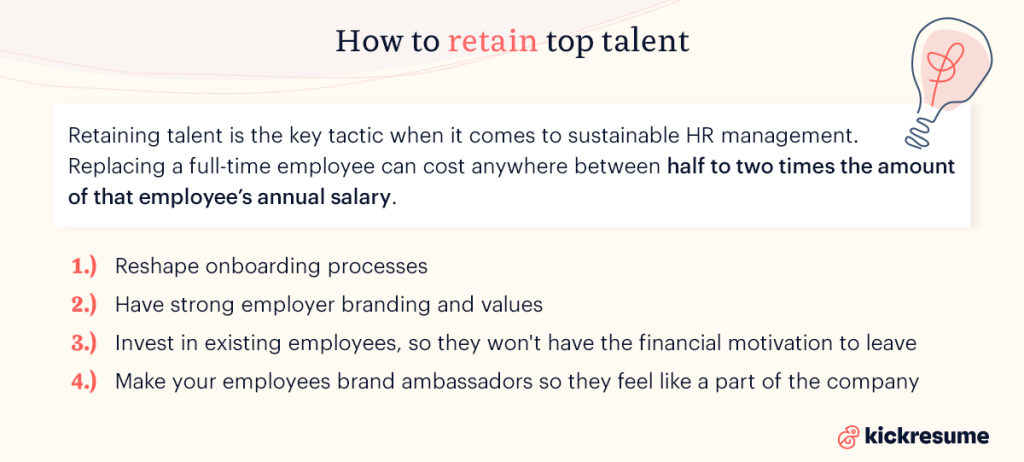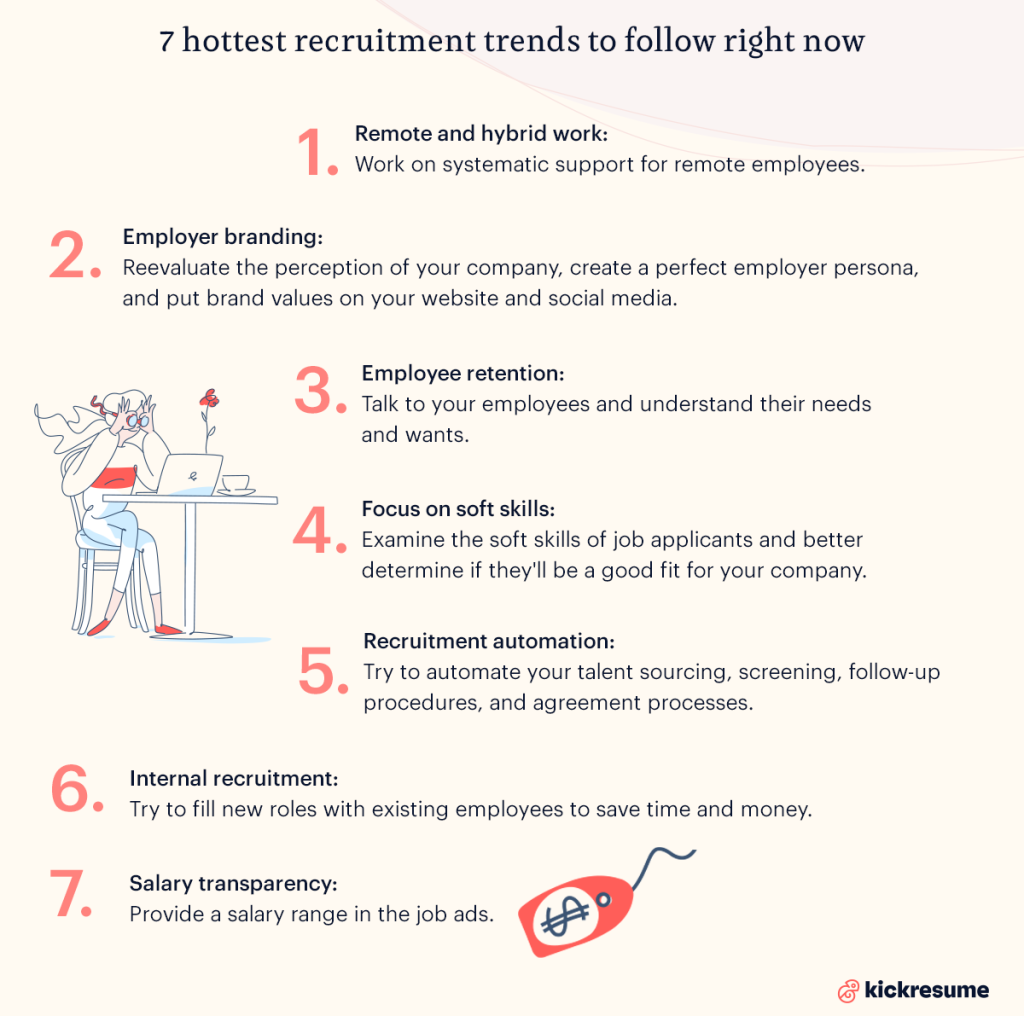Have you heard of the big resignation? Quiet quitting? Social recruiting? Probably yes, as the recruitment trends of the recent years attracted a lot of attention. And there’s a good reason for it.
The recruitment landscape is shifting dramatically. In 2022, an estimated 50.5 million people quit their jobs, demanding more from their employers. What started as a post-pandemic phenomenon is back in full force.
According to the Bureau of Labor Statistics, 3.3 million U.S. workers quit in October 2024 alone.
And, according to a 2024 research from Microsoft and LinkedIn, nearly half (46%) of professionals say they’re considering quitting in the year ahead.
In order to keep up with the changes, we’ve rounded up the 7 hottest recruitment trends to watch out for in 2025:
- remote and hybrid work
- employer branding
- employee retention
- the focus on soft skills
- recruitment automation
- internal recruitment
- salary transparency
Let's see what these trends mean for you and your career!
1. Remote and hybrid working
The trend of remote and hybrid work has been here for a while, and its popularity is expected to only grow thanks to its many benefits and demand.
A FlexJobs survey shows that 63% of professionals are willing to take a pay cut to work remotely. Additionally, the demand for remote work has increased fivefold over the past five years.
Thanks to this preference, anyone looking for a new job now will seek a hybrid or remote job, and companies will need to accommodate them.
However, this shouldn’t be too hard since the benefits of remote work outweigh the negatives.
The four biggest benefits of remote work are:
- Lower costs. Since the workers don’t go to the office on a regular basis, companies can save on utilities, office equipment, and more.
- Increased productivity of employees. There are usually fewer distractions at home. No more never-ending coffee breaks! Moreover, remote workers don’t commute, which allows them to have a better work-life balance. That’s an essential factor that plays into increased productivity. When employees have more flexibility, they're empowered, which makes them happier and more proactive.
- Increased talent pool. Once a company opens up its job postings to remote talent, it can hire the best people out there, no matter in which country they reside.
- Reduced employee turnover. Providing flexibility through remote work arrangements can improve job satisfaction and employee retention. When employees have the option to work in an environment that suits their lifestyle and preferences, they're more likely to stick around.
With this recruitment trend growing in the HR landscape, it’s essential to work on the process of systematic support for remote employees.
Ideally, this process should be in place right from the beginning to attract potential remote employees. In fact, job seekers are likely to inquire about such a system during interviews.
2. Employer branding strategies
Employer branding is becoming essential for companies looking to attract top talent, especially in the remote landscape. The stronger your employer branding is, the easier it will be to get high-quality responses to your job listings.
Employer branding refers to any marketing efforts that specifically target potential new employees.
With the changes in the recruitment landscape, being an attractive option for job seekers is a must.
After all, the job interviewing process works both ways, and job seekers are just as interested in learning about the benefits of working for a specific company.
Employer branding helps:
- attract new employees
- stand out from the competition
- increase brand awareness
So, how should you do this?
The best way to go about creating an employer strategy is to:
- Reevaluate the perception of a company and brand. It could be done through social listening and short polls. The more data, the better.
- Flesh out a perfect employee persona. Knowing exactly what it takes to be a good fit for a specific company will speed up the recruitment and hiring process.
- Put brand values front and center. What your brand stands for should be evident on your website and social media.
- Ultimately, people should be the focus of all employer branding strategies. For example, you can show how much employees grew with your company, as well as how your company supported them.

3. Shifting the focus on employee retention
While you might think that employee retention shouldn’t be a part of the recruitment process, it's actually the key tactic when it comes to sustainable and healthy HR management.
It doesn’t make sense to attract new employees if you can’t keep them for longer than 3 months.
Furthermore, hiring a new employee can cost up to two times the amount of that employee’s annual salary, according to research.
With those high numbers, it’s safe to say that employee retention should get more attention in 2025.
There are different ways you can ensure retaining talent:
- reshaping your onboarding process
- having a strong employer branding
- investing in your employees
- making your employees brand ambassadors
Essentially, anyone interested in employee retention should start by talking to their employees and understanding their needs and wants.
Do they want more coaching opportunities, educational workshops, incentives, or anything else?
As a result, understanding your current employees will give you a lot of valuable data that could be used in the recruitment process.
4. Focus on soft skills
With the rise of remote work, employers have become aware of the true power of soft skills. So there has been an expected rise in the importance of soft skills during recruitment.
While hard skills connected to the specific job role are essential, in order to truly know whether the person will be a good fit for a company and its culture, they need to have specific soft skills.
Soft skills refer to personal traits, for example:
For example, soft skills show whether a candidate will have a hard time working in a team or communicating with hire-ups and stakeholders.
They can also be a great indicator of a reliable employee that has great time management and can stick to their deadlines.
In fact, 9 out of 10 global executives agree that soft skills are more important than ever, according to a LinkedIn survey. Furthermore, 92% of employers believe that soft skills and skill matrix are as important as hard skills.
5. Recruitment automation
This recruitment trend can save you time and effort while increasing the quality of the process.
There are different phases of the recruitment process that can be automatized:
- talent sourcing
- screening
- the follow-up procedure
- the agreement process
- automatic talent matching
Why is recruitment automation becoming increasingly necessary?
Because 85% of Gen Z applicants agree that the job search process is outdated, and 2 out of 5 will abandon the recruitment process before the interview if they feel like the whole process is too complicated.
By automating your recruitment process, you can create a streamlined and efficient system that keeps potential hires engaged, which leads to more high-quality candidates.
For example, using a pre-written recruitment proposal with features like payment integrations and digital signatures (which are essential for remote workers) can save you time on administrative work and the follow-up process.
Or you can use a platform like Talent Hub that automatically matches you with relevant candidates, based on your job ad and requirements.
6. Internal recruitment
Another recruitment trend on the rise is filling new roles with existing employees.
People are the biggest capital a company can have, and investing in them always pays off.
Training employees to take over leadership roles provides amazing results. That’s because existing employees already know so much about the company, products, and services, which is something new hires can’t keep up with.
When a company engages in internal recruitment:
- It shows other employees that the same could happen to them, which in turn makes them more proactive and productive.
- It’s cost-effective. We already mentioned the costs of hiring new employees; however, in this case, you don't have to invest in onboarding and training or a relocation package.
- It also saves time since the existing employee can jump straight into the work and already knows all of their coworkers and company processes.
7. More transparency in salary decisions
With the Millennials and Generation Z becoming the majority of the working force, some things are bound to change.
One of them is eliminating the stigma surrounding the money talk.
Even though it’s still not federally required in the U.S., salary transparency is a rising trend that’s giving more power to potential employees. However, things are looking up. Since 2023, some states have made it a rule that job ads must include the salary range.
Thus, make sure to also always provide salary ranges in the job advertisements.
Salary transparency helps to:
- Save time. Since potential hires will no longer engage in the hiring process only to give up once they hear the projected salary.
- Increase diversity among employees. It's a great way to bring down the wage gap between the sexes, as well as races.
- Forge relationships in the company. Since the salary rates are out in the open, there's no need for any unpleasantness around the office when it comes time for a raise or bonuses.

Key takeaways: Recruitment trends for 2025
Understanding recruitment trends can help hiring managers, companies, and job seekers experience better success rates.
In 2025, you should focus on:
- Remote and hybrid work: Work on the process of systematic support for remote employees.
- Employer branding: Reevaluate the perception of your company, create a perfect employer persona, put brand values on your website and social media, and engage employees in your employer branding strategies.
- Employee retention: Start by talking to your employees and understanding their needs and wants. Do they want more coaching, workshops, or anything else?
- Soft skills: They'll help you determine whether the person will be a good fit for your company.
- Recruitment automation: Try to automatize your talent sourcing, screening, follow-up procedure, or agreement process.
- Internal recruitment: Try to fill new roles with existing employees.
- Salary transparency: Avoid salary discrimination and job application dropouts by providing salary ranges in the job postings.
By focusing on these things, you'll be one step ahead.



